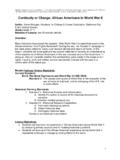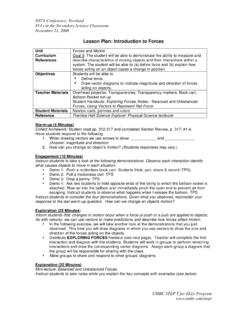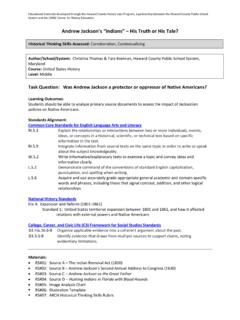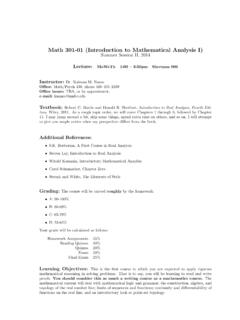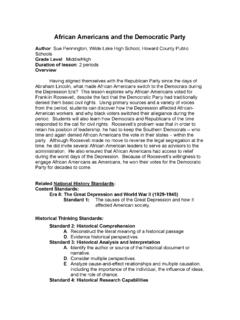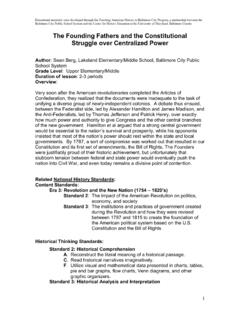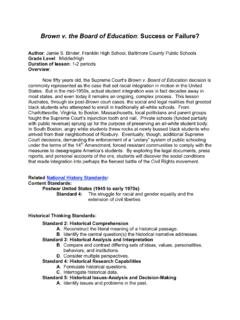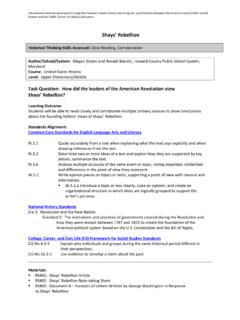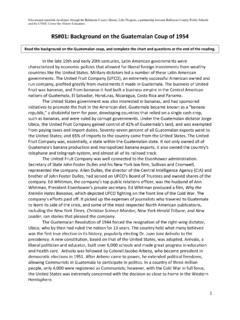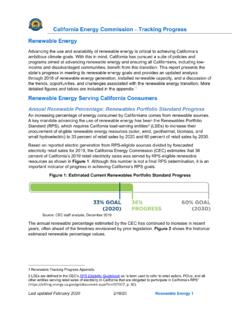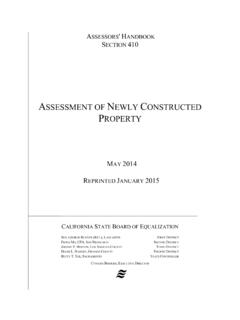Transcription of Post-War Suburbanization: Homogenization or the American ...
1 Post-War Suburbanization: Homogenizationor the American Dream?<Introduction & History Standards>Author: Bruce Lesh, Franklin High School, Baltimore County Public SchoolsGrade Level: HighDuration of lesson: 1 periodOverview:The years after World War Two saw a massive movement of people into new growth of suburbs resulted from several historical forces, including the social legacyof the Depression, mass demobilization after the War (and the consequent babyboom ), greater government involvement in housing and development, the massmarketing of the automobile, and a dramatic change in demographics. As familiesbegan moving from farms and cities into new suburbs, American culture underwent amajor transformation. Race and class dynamics began to shift; the longer distancebetween home and work generated a highway and housing construction boom; andolder community institutions began to disappear as the family turned this lesson, students will critically evaluate primary and secondary sources of theperiod, in order to discern the causes for suburban development after the Second WorldWar.
2 They will determine whether this cultural trend created more opportunity for livingthe American Dream, or whether suburbanization led to the Homogenization ofAmerican culture and political life. In exploring the extent to which certain historicaltrends were inevitable, students will learn that historical interpretations are tentative andoften National History Standards:Content Standards:Era 9: Postwar United States (1945 to early 1970s)Standard 1: The economic boom and social transformation of postwarUnited StatesHistorical Thinking Standards:Standard 1: Chronological ThinkingF. Reconstruct patterns of historical succession and 3: Historical Analysis and InterpretationC. Differentiate between historical facts and historical Consider multiple Analyze cause-and-effect relationships and multiple causation,including the importance of the individual, the influence of ideas, andthe role of Challenge arguments of historical Compare competing historical Hold interpretations of history as Evaluate major debates among Objectives: Students will identify factors that promoted rapid Post-War suburbanization.
3 Students will contrast various interpretations of the impact of post-warsuburbanization. Students will assess the degree to which Post-War suburbanization impactedAmerican BackgroundPopulation movement has been a defining characteristic of the humanexperience since the emergence of modern humanity. The American experience isreplete with examples of people moving from one location to another to alter theireconomic, political, or social circumstances. The Great Migration of African Americansfrom the south to northern and western urban centers, the movement of Dust Bowlvictims to California, and the movement off of farms into cities during the early 20thcentury all serve as examples of populations moving in the United States. Thisphenomenon manifested itself again at the conclusion of the Second World War, whenan increased number of Americans moved from the cities and rural areas to thesuburbs, exacerbating a process that had its antecedents in the pre-war world but foundits greatest expression in the Post-War climate of demobilization and economic growththat followed V-E and V-J Days.
4 In fact eighteen of the nation s top twenty-five citiessuffered a net loss of population between 1950 and 1970, with suburban population doubling from 37 to 74 million people during the same time period (Jackson 283).These new population centers came to redefine American life and presented newchallenges for America s commitment to equality and opportunity. Causality for themassive movement of people into the suburbs at the conclusion of World War Twocannot be attributed to one singular factor. It was instead the confluence of the legacy ofthe Depression and the Second World War, a housing shortage exacerbated by Post-War demobilization, involvement of the federal government, the growth of technology,and a dramatic change in demographics that led to the dramatic population shift that stillimpacts America Great Depression and the Second World War altered the economicperspective of many Americans. The realities of the prolonged economic downturn thatdefined American life from 1929 until 1941 forced many Americans out of work and intosacrificing numerous consumer goods to which they had grown accustomed to in the1920s.
5 The advent of global war enabled most Americans to find work, either in themilitary or the private sector catering to military needs. In addition, wages and savingsincreased during the war, but consumer spending did not. The rationing of cars,appliances, food, clothing, and other goods restricted the ability of most Americans tospend the hard earned wages they received during the war. Late 1945, after V-E Dayand V-J Day, Americans were freed from both economic depression and the majority ofthe war time spending constraints. Although some shortage s and rationing continuedinto 1946, Americans found an outlet for their pent-up consumerism and looked to takeadvantage of this new found economic freedom by spending on many consumer items,most notably automobiles, homes, and the remarkable number of new babies beingbrought into the of the first necessities sought after by Americans was housing. By late 1945and early 1946 the housing crisis was acute. Veterans and other Americansdemobilized from wartime production desired housing but were met with a lack ofsupply.
6 Demand for housing was so serious that the city of Chicago, in 1945, sold 250old streetcars as possible homes. In addition, Omaha saw a newspaper advertisementthat offered a 7X17 icebox that could be fixed up to live in (Who Built America, 592).To stimulate the growth of the housing market and reduce the financial constraints suchas ten year mortgages, and the need for eighty percent down payments, the federalgovernment instructed the Federal Housing Authority (FHA) to allow thirty yearmortgages and approve mortgages with only ten percent down (Patterson, 72). Withgreater access to loans, the possibility of affording housing increased for millions ofAmericans. Complimenting this effort was the federal government s response to thedemands of Veterans by passing a groundbreaking piece of by the American Legion, and memories of issues facing demobilized WorldWar One veterans, the United States Congress passed the Sevicemen s ReadjustmentAct of 1944. Dubbed the Bill, this path-breaking federal legislation openednumerous opportunities for veterans to smoothly transition from wartime service topeacetime civilian life.
7 Central to the legislation were provisions to address education,housing, and employment. The bill subsidized tuition, fees, books, and educationalmaterials for veterans desiring to attend college. In addition, it assisted in the livingexpenses incurred during the pursuit of a degree. The connection to the growth of thesuburbs is found in the provision providing low interest loans to veterans for thepurchase of single family homes (Bennett, 249-259). With access to cheap moneyveterans and their growing families sought relief from the housing shortages by movinginto the growing suburbs accessible only by the ownership of an automobile andconnected to their workplaces by the growing network of access suburban housing Americans needed transportation. This practicalneed was quickly satisfied because of the American love affair with automobiles and theefforts of varying groups to accelerate the construction of a system of automobiles were a factor before the war, it was after World War Two thatthey became the new necessity for Americans.
8 Freed up from rationing that severelylimited the supply of automobiles Americans used some of their surplus money topurchase a family car. The growth of automobiles in turn provided another impetus tomove out of the city. With access to a personal form of transportation families could livea distance from work and still be able to travel to and from work without much of the impacts automobiles had on suburbanization can be traced to lobbyingefforts of auto makers, construction companies, and cement contractors (Jackson, 234-235) In 1956 road construction exploded, and access to the suburbs expanded greatly,due to the passage of the National Interstate and Defense Highways Act. This act,which extended the highway construction inaugurated in the 1944 Federal Aid-HighwayAct, provided massive federal funding, over 90% of the projected costs, for theconstruction of 41,000 miles of interstate highways( , and Jackson, 235). This act facilitated acontinual movement of people to the suburbs and enabled many Americans to raisetheir growing families in localities farther and farther from American 1946 and 1964 the United States witnessed the baby boom.
9 Eachyear the number of babies born in the United States averaged million. One of manynotable impacts that this generation had on the United States was the need for newhomes to be constructed for them to live in. In addition, the dramatic increase inpopulation spurred a boom in the consumption of consumer goods. Toys, diapers,educational supplies, and other necessities of raising children positively impactedconsumer spending and aided in the quick rebound of the American Post-War for many new families was housing which was more frequently to be found notin cities, but in the suburbs emerging farther and farther from the center of majormetropolitan the release of pent up consumer spending, the explosion of population,opportunities provided by the Bill and the changes stemming from the automobilethe opportunity was ripe for the suburbs. Emblematic of those that took advantage ofthis new market were the Levitt brothers, William and Alfred. Although building housesprior to the war, it was the occasion to receive a contract to construct military homes inNorfolk, Virginia, which allowed the Levitts to realize the benefits of mass-producinghomes.
10 When the war ended the Levitts purchased land once used to grow potatoesand constructed in Hempstead Long Island the first of three Levittowns. The LongIsland, Pennsylvania, and New Jersey developments were to provide residents withaffordable housing and all of the amenities that they had come to expect from living inthe city. The construction process was vertically integrated to reduce costs. The Levittsowned the forest where the lumber was forested, the mill in Oregon where the lumberwas manufactured, made their own nails, and cement, and prefabricated the structuresused to construct homes (Patterson, 72). In addition, they controlled prices forappliances by purchasing directly from the manufacturers. Well paid, but non-unionlabor also aided in the construction of the homes. Production was broken down intotwenty-seven discrete steps, which at one point enabled the Levitts to construct a housein a matter of minutes. Once the houses were constructed the Levitts added baseballfields, swimming pools, shopping centers, schools, parks, and churches to theirneighborhoods.
